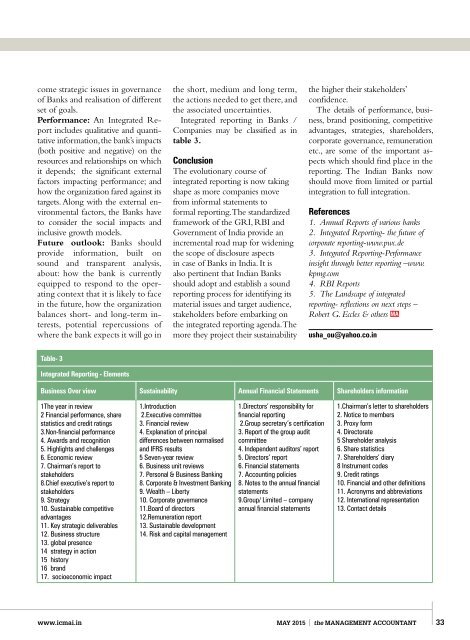May-2015
May-2015
May-2015
You also want an ePaper? Increase the reach of your titles
YUMPU automatically turns print PDFs into web optimized ePapers that Google loves.
come strategic issues in governance<br />
of Banks and realisation of different<br />
set of goals.<br />
Performance: An Integrated Report<br />
includes qualitative and quantitative<br />
information, the bank’s impacts<br />
(both positive and negative) on the<br />
resources and relationships on which<br />
it depends; the significant external<br />
factors impacting performance; and<br />
how the organization fared against its<br />
targets. Along with the external environmental<br />
factors, the Banks have<br />
to consider the social impacts and<br />
inclusive growth models.<br />
Future outlook: Banks should<br />
provide information, built on<br />
sound and transparent analysis,<br />
about: how the bank is currently<br />
equipped to respond to the operating<br />
context that it is likely to face<br />
in the future, how the organization<br />
balances short- and long-term interests,<br />
potential repercussions of<br />
where the bank expects it will go in<br />
the short, medium and long term,<br />
the actions needed to get there, and<br />
the associated uncertainties.<br />
Integrated reporting in Banks /<br />
Companies may be classified as in<br />
table 3.<br />
Conclusion<br />
The evolutionary course of<br />
integrated reporting is now taking<br />
shape as more companies move<br />
from informal statements to<br />
formal reporting. The standardized<br />
framework of the GRI, RBI and<br />
Government of India provide an<br />
incremental road map for widening<br />
the scope of disclosure aspects<br />
in case of Banks in India. It is<br />
also pertinent that Indian Banks<br />
should adopt and establish a sound<br />
reporting process for identifying its<br />
material issues and target audience,<br />
stakeholders before embarking on<br />
the integrated reporting agenda. The<br />
more they project their sustainability<br />
the higher their stakeholders’<br />
confidence.<br />
The details of performance, business,<br />
brand positioning, competitive<br />
advantages, strategies, shareholders,<br />
corporate governance, remuneration<br />
etc., are some of the important aspects<br />
which should find place in the<br />
reporting. The Indian Banks now<br />
should move from limited or partial<br />
integration to full integration.<br />
References<br />
1. Annual Reports of various banks<br />
2. Integrated Reporting- the future of<br />
corporate reporting-www.pwc.de<br />
3. Integrated Reporting-Performance<br />
insight through better reporting –www.<br />
kpmg.com<br />
4. RBI Reports<br />
5. The Landscape of integrated<br />
reporting- reflections on next steps –<br />
Robert G. Eccles & others<br />
usha_ou@yahoo.co.in<br />
Table- 3<br />
Integrated Reporting - Elements<br />
Business Over view Sustainability Annual Financial Statements Shareholders information<br />
1The year in review<br />
2 Financial performance, share<br />
statistics and credit ratings<br />
3.Non-financial performance<br />
4. Awards and recognition<br />
5. Highlights and challenges<br />
6. Economic review<br />
7. Chairman’s report to<br />
stakeholders<br />
8.Chief executive’s report to<br />
stakeholders<br />
9. Strategy<br />
10. Sustainable competitive<br />
advantages<br />
11. Key strategic deliverables<br />
12. Business structure<br />
13. global presence<br />
14 strategy in action<br />
15 history<br />
16 brand<br />
17. socioeconomic impact<br />
1.Introduction<br />
2.Executive committee<br />
3. Financial review<br />
4. Explanation of principal<br />
differences between normalised<br />
and IFRS results<br />
5 Seven-year review<br />
6. Business unit reviews<br />
7. Personal & Business Banking<br />
8. Corporate & Investment Banking<br />
9. Wealth – Liberty<br />
10. Corporate governance<br />
11.Board of directors<br />
12.Remuneration report<br />
13. Sustainable development<br />
14. Risk and capital management<br />
1.Directors’ responsibility for<br />
financial reporting<br />
2.Group secretary’s certification<br />
3. Report of the group audit<br />
committee<br />
4. Independent auditors’ report<br />
5. Directors’ report<br />
6. Financial statements<br />
7. Accounting policies<br />
8. Notes to the annual financial<br />
statements<br />
9.Group/ Limited – company<br />
annual financial statements<br />
1.Chairman’s letter to shareholders<br />
2. Notice to members<br />
3. Proxy form<br />
4. Directorate<br />
5 Shareholder analysis<br />
6. Share statistics<br />
7. Shareholders’ diary<br />
8 Instrument codes<br />
9. Credit ratings<br />
10. Financial and other definitions<br />
11. Acronyms and abbreviations<br />
12. International representation<br />
13. Contact details<br />
www.icmai.in<br />
MAY <strong>2015</strong> the MANAGEMENT ACCOUNTANT 33


